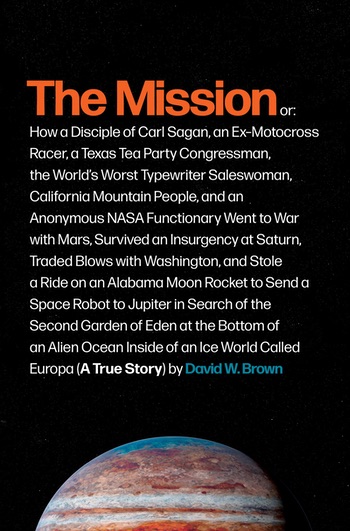Review: The Missionby Jeff Foust
|
| Going from the idea of sending a spacecraft to Europa to getting the Europa Clipper mission formally started was not a straightforward, linear progression, and neither is this book. |
That is just the latest twist in what has been a convoluted development of Europa Clipper, one where scientific and political advocacy faced off against budgets and institutional inertia. The Mission, a new book by David Brown, tells the story of the battle to get Europa Clipper started, one involving an alliance of scientists, engineers, politicians, and agency insiders.
Concepts for missions to Europa date back to the 1990s, as data from the Galileo mission orbiting Jupiter showed that the icy moon has a subsurface ocean of liquid water that, along with a source of energy and organic compounds, gave it the necessary ingredients to support life. Some of those early concepts, though, foundered on technical issues, like the intense radiation environment around Europa, as well as budgets and competing priorities, notably Mars. However, a small group kept the door on a Europa mission from closing entirely, securing an endorsement in a planetary science decadal survey in 2001 and a trickle of funding for studies until it could develop a stronger base of support, particularly from then-Rep. John Culberson (R-TX), a House appropriator who pushed for funding for the mission over the objections of the White House and NASA.
Culberson is just one of the characters in The Mission. Others include planetary scientists Bob Pappalardo and Louise Prockter, who were early advocates for a mission to Europa; Curt Niebur, who worked from NASA Headquarters to keep a Europa mission alive; and Karla Clark, an engineer at JPL involved with many of the early Europa mission design studies. Their efforts, and their life stories, are weaved into the book along with many other supporting players.
Going from the idea of sending a spacecraft to Europa to getting the Europa Clipper mission formally started was not a straightforward, linear progression, and neither is this book. Brown dives in and out of the story of the mission itself, with frequent and often lengthy digressions to tell the backstories of the people involved, or to go on any number of tangents related to policy, technology, or even the formation of the solar system. It can be like an engaging conversation that flows and meanders, but sometimes leaves you wondering just how this all fits into the mission itself.
| In the book, backers of the Europa mission complain bitterly about the “absurd” cost estimate of $4.7 billion assigned to the Europa orbiter mission in the decadal survey released in 2011. When Europa Clipper passed a review called Key Decision Point C in August 2019, the agency’s formal cost estimate for the mission was $4.25 billion. |
That tone is evident in the book’s cover-spanning subtitle: “Or, How a Disciple of Carl Sagan, an Ex-Motocross Racer, a Texas Tea Party Congressman, the World's Worst Typewriter Saleswoman, California Mountain People, and an Anonymous NASA Functionary Went to War with Mars, Survived an Insurgency at Saturn, Traded Blows with Washington, and Stole a Ride on an Alabama Moon Rocket to Send a Space Robot to Jupiter in Search of the Second Garden of Eden at the Bottom of an Alien Ocean Inside of an Ice World Called Europa.” Whew. At times Brown can be very informal; it may take the reader time to realize that when he refers to the “mountain people of Saint Gabe,” he’s referring to employees at JPL, located in the foothills of the San Gabriel Mountains. Yet other times he stretches to be erudite: in a passage about Saturn’s icy moon Enceladus, he describes the world as “though Gaspard Marsy himself had carved the white marble moon with hammer and chisel.” An endnote two pages long explains Marsy was a sculptor who created a statue of Enceladus in the garden of Versailles, and told the story of that Greek mythological figure.
The book ends long before the present day, when Europa Clipper became a formal project in 2015, its future seemingly secured. That means we miss the ups and downs of the last several years, including the departure of Culberson as the mission’s patron (losing reelection in 2018 in part because his opponent argued he was spending more attention on Europa than on local issues), problems with instruments that led to the replacement of a magnetometer and changes to others, and cost growth. In the book, backers of the Europa mission complain bitterly about the “absurd” cost estimate of $4.7 billion assigned to the Europa orbiter mission in the decadal survey released in 2011. When Europa Clipper passed a review called Key Decision Point C in August 2019, the agency’s formal cost estimate for the mission was $4.25 billion: not so absurd after all.
Despite these problems, Europa Clipper perseveres, and is on track for a launch in 2024 that will allow the spacecraft to arrive in 2030 (a drawback to not using the SLS is a flight time about twice as long.) The Mission helps explains why the mission is so compelling, but also so difficult to get started.
Note: we are temporarily moderating all comments submitted to deal with a surge in spam.
